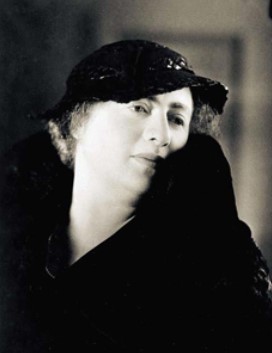Irma Stern
 On 23 August 1966, South African painter Irma Stern died at the age of 71. Although accepted in Europe, her work was unappreciated at first in South Africa where critics derided her early exhibitions in the 1920s with reviews titled "Art of Miss Irma Stern - Ugliness as a cult". Today her paintings are among the most expensive from South Africa.
On 23 August 1966, South African painter Irma Stern died at the age of 71. Although accepted in Europe, her work was unappreciated at first in South Africa where critics derided her early exhibitions in the 1920s with reviews titled "Art of Miss Irma Stern - Ugliness as a cult". Today her paintings are among the most expensive from South Africa.
Irma Stern was born on 2 October 1894 in Schweizer-Reneke, a small town in the Transvaal, of German-Jewish parents. Her father was interned in a concentration camp by the British during the South African War because of his pro-Boer sentiments. Irma and her younger brother Rudi were therefore brought to Cape Town by their mother. They returned to Germany from 1901 to 1909 and settled in Berlin. In the following years the family changed their place of residence several times between Germany and South Africa.
In 1913 Irma left South Africa to study art at the Weimar Academy in Germany but she later transferred her studies to the Levin-Funcke studio in Berlin. However, it was only when she met German Expressionist Max Pechstein (1881–1955), that she felt she had found a true mentor. Between 1918 and 1919 her works were included in a number of exhibitions in Germany and she held her first solo exhibition in Berlin in 1919 at the Fritz Gurlitt Gallery, after which she returned to South Africa.
Irma Stern’s first solo exhibition in South Africa was held at Ashbey’s Gallery in Cape Town in 1922. In the conservative Cape Town art world her work shocked and outraged critics and audiences. According to South African cartoonist D.C. Boonzaier, the exhibition even elicited a police investigation into complaints of public indecency. Over the years, Stern gradually won acceptance and eventually acclaim - not least because of her successes and exhibitions in Germany, France and England.
Throughout her life, Irma Stern traveled extensively in Europe and explored Southern Africa, Zanzibar and the Congo. These trips provided a wide range of subject matter for her paintings and gave her opportunities to acquire and assemble a collection of artefacts for her home. On Irma Stern’s death in 1966, her home in Rondebosch and its contents became a national legacy. In 1972 the Irma Stern Museum was opened.
Today Irma Stern’s work fetches impressive prices at auctions. In 2011, her portrait of an Arab priest at Bonhams in London was sold for over three million euros - a record to this day for the work of a South African artist.
Source: Wikipedia & Jewish Women: A Comprehensive Historical Encyclopedia
Selected publications
Irma Stern : African in Europe, European in Africa / Sean O'Toole. - Munich : Prestel, [2020]
A passionate vision: the story of Irma Stern / Katherine Graham and Suné Raubenheimer. - Lansdowne, South Africa : The Vine Publishers, [2017].
Pictures that satisfy: Modernist discourses and the politics of race, gender, and nation in the art of Irma Stern (1894–1966) / LaNitra Michele Walker. - ProQuest Dissertations Publishing, 2009
Irma Stern : the early years, 1894-1933 / Karel Schoeman. - Cape Town : South African Library, 1994.
Different visions : a comparison of the Central African collections of W.F. Burton and Irma Stern / Patricia Davison.
In: Social dynamics : a journal of the Faculty of Social Science, University of Cape Town , vol. 19, no. 1, p. 26-38, 1993
Catalogue of the collections in the Irma Stern Museum / Irma Stern Museum (Cape Town). - Cape Town : University of Cape Town, 1971
Irma Stern and the spirit of Africa / Joseph Sachs. - Pretoria : J. L. van Schaik, 1942
See also: Who is South African Artist Irma Stern? / Lillian Gray. - Lillian Gray Art School blog, 5 May 2020 and Lillian Gray's art history video on Irma Stern on YouTube (23:41 min)
Irma Stern: A life well travelled. - Sotheby's, 30 sep. 2020 (04:12 min)
Timeline of 20th-century South African women artists via Wikidata and DBpedia

